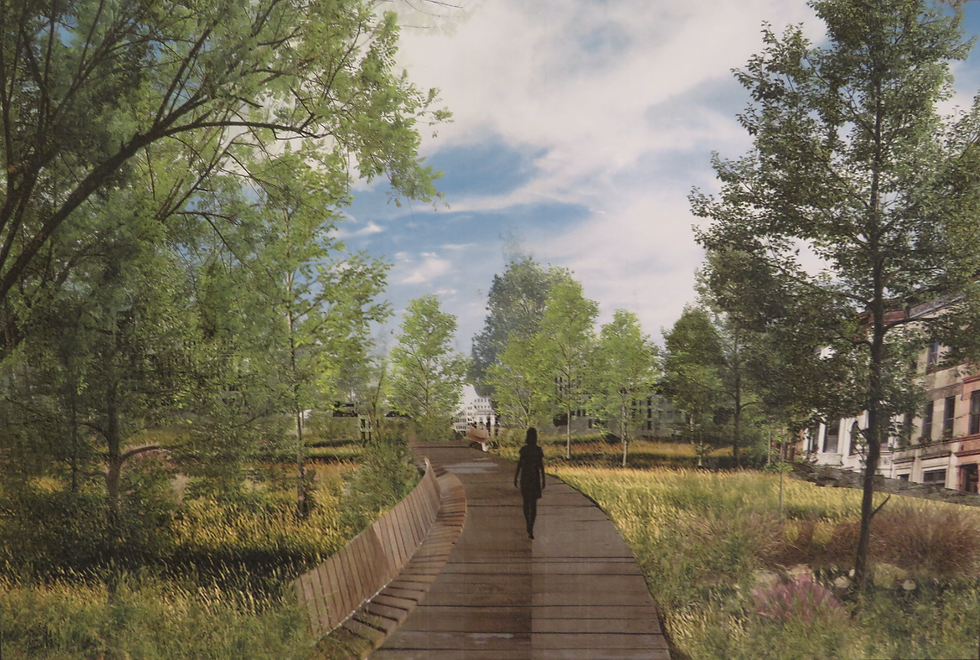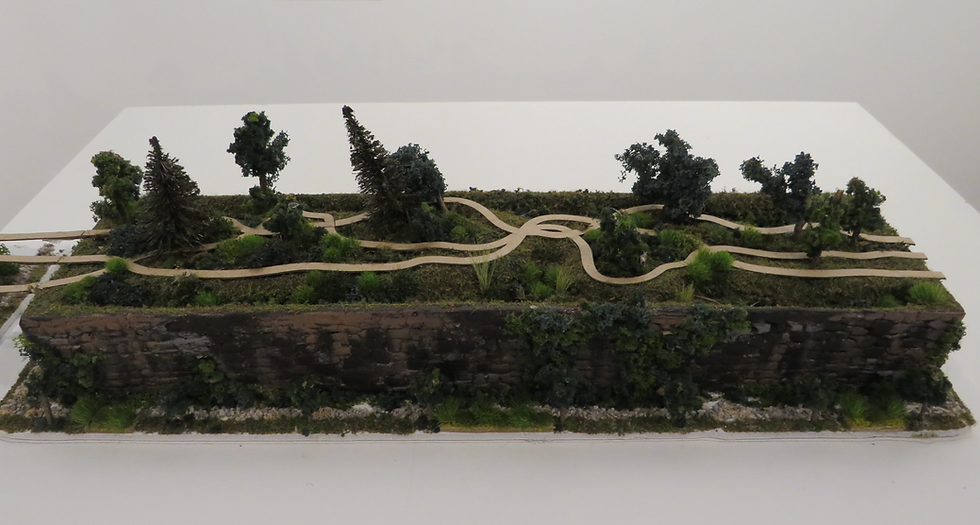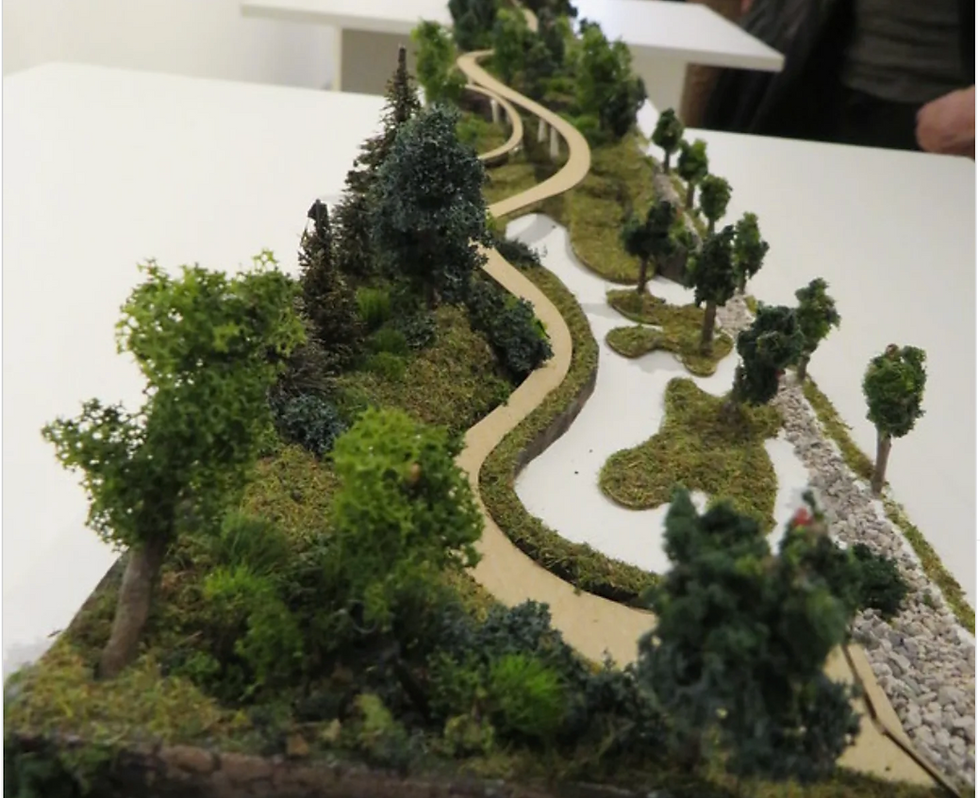“Envisioning Our Future”
- Eye Level
- Jul 15
- 5 min read
At Casa Colombo, plans for projects perennially incomplete: the Embankment and Bergen Arches.

We have thoughts about the Sixth Street Embankment. It would be odd if we didn’t. Anything that heavy is bound to leave an impression on sensitive souls. The great stone sleeper has dozed for years, unperturbed, as the rest of the town has changed around it. Court cases, environmental studies, and action plans from transportation agency aside, our ongoing reluctance to change the Embankment has a superstitious quality about it. Do we see it as a giant paperweight, without which the entire Downtown will fly away into the turbine of international capitalism? Or does the long black wall feel more like the body of a beast, a serpent from a Hudson County version of Midgard, inviolable and primordial, and too dangerous to touch?
Thus artists who’ve tangled with the Embankment have done it with an abundance of respect. When the Zombie Opera wanted an otherworldly site for a supernatural-themed pop-up show, they called upon our Sixth Street Stonehenge to set the transcendent mood. “The Embankment on My Mind,” a blowout 2022 exhibition at New Jersey City University, gathered forty-three artists for a confession of mass fascination with the structure’s curious power. Awed participants barely needed to mythologize the Embankment. All they had to do was show it: the skin-like stone, the thick, forbidding vegetation, the accidental habitat for birds and beasts, the mute but articulate link to Jersey history.
“Envisioning Our Future” at Casa Colombo (380 Monmouth St.) takes a more sober approach to its subject than the University art department did. The language is scientific, and the tone is cautious and diagnostic. Yet like its predecessor at NJCU, it is a work of imagination. It is a dream of what the Sixth Street Embankment could be in the hands of a benevolent but rather severe developer. Curators Dr. Frank Gallagher and Haemee Han of the Environmental Design Studio at Rutgers extend their speculative labor to the Bergen Arches, the long-abandoned rail cut that once linked the main industrial line to the waterfront, and now, overgrown and fenced away, provides a Narnian escape for urban explorers. Their approach is methodical, their design choices are infographical, and their requests feel entirely reasonable. Nevertheless, the show still feels like a fairytale — as far removed from the forces currently shaping Jersey City as the fantastic work of the forty-three artists, and maybe even the zombies.

Because of its street-straddling length, the Embankment has often been envisioned as a homegrown answer to the High Line. Why couldn’t we have a junior version of the elevated trail that links the West Village and Chelsea to Hudson Yards and the fringes of Midtown Manhattan? It seems like a practical use of an available resource. “Envisioning Our Future” curators Dr. Frank Gallagher and Haemee Han get into the High Line action with designs of their own, including multi-panel renderings of an Embankment that could be, affixed to the gallery wall like digital art in a collegiate lab, and a solemn three-dimensional model strung along several tables.

The architects thread sinuous paths through trees, lawns, and rock gardens, and run footbridges over negative space that stands for Coles, Monmouth, and other north-south streets. The park is austere, unadorned, and as anticommercial as LSP. The palette is muted: we see the ivy-green of dense foliage, the beige of cut timber, the bright white of sandtraps. Even the wildflowers are understated. So this humble version of the Embankment stretches on, block by block, until it meets a Bergen Arches redesigned according to a similar aesthetic.
Compared to other city projects, it does not seem like it would be terribly costly to build. Money may not the biggest obstacle. Realizing this vision means getting cooperation from stakeholders with very different agendas: environmentalists, architects, planners, affordable housing advocates, banks, lawyers, and politicians, and developers who, without the intervention of community groups, would have turned the Embankment into a platform for their real estate projects long ago. Even if the Embankment Preservation Coalition — sponsor of “Envisioning Our Future” — can hammer out a compromise deal with the builders that would allow for greenspace, they’ve got to gamble that the city will renovate the structure in a manner that’s sensitive to the biome that the Embankment has become. The trees, birds, and butterflies that have taken over the structure might not appreciate a well-meaning infusion of municipal concrete.
Then there’s the heavy in the story: the Embankment itself, with its peculiar gravity, its recalcitrant personality, and its stubborn refusal to roll over for planners and their aims. Designers tend to want to extend their levity to their work, but the Embankment is taciturn. Five years ago, the Argentine architect Jorge Mastropietro came to us with a proposal for a Jersey City Arts Line atop the stone walls in which each segment devoted to a different muse — an awfully regimented thing to do to a place so wild. Mastropietro’s mock-ups of the Arts Line de-emphasized the thick black rock, rough-hewn, uneven, and suggestive of muscle and the might of public works, that gives Sixth Street so much of its character. Instead, we had neat lines, crisp right angles and an emphasis on cultural utility. It felt like a vain attempt to control something indomitable.

The Rutgers architects of “Envisioning Our Future” don’t make the same mistake. Even as they frame their printouts with facts and recommendations, they’re careful to ground their renderings in the industrial history of the neighborhood. Everything, including their models, hints of the railyards. Yet there’s a spectral feeling to the illustrations, too — a weighty silence that hovers over the slide-like images of the Embankment and Bergen Arches that could be, drawn from the Embankment and Bergen Arches that are. Given the feel of their images, it doesn’t feel incongruous at all that Gallagher and Han choose to populate their park with shadows. What few human figures allowed on these walkways are tar-black cutouts against the green. They’re anonymous: negative space knocked out of the diorama of nature, just as the Embankment itself is negative space on the grid of the post-industrial Downtown.
This may be architectural convention. But in “Envisioning Our Future,” it’s honest. Deep down, We can’t approach the Embankment with intent to change it without hanging our heads. We’re ashamed to desecrate the resting place of a member of our local pantheon: something that seems eternal (or at least older than we are), something that exists out of time, a rude fact, reminding us of the city we were. Maybe only after we’ve grappled with that can we find our faces, and only after we’ve found those faces can we dare to make alterations to holy ground.
(The art gallery at Casa Colombo is open on Wednesdays and Thursdays from 10 a.m. until 3 p.m. and on Saturdays from 1 p.m. until 4 p.m.)




